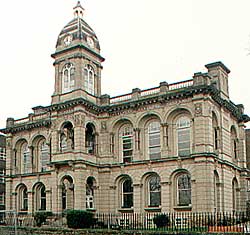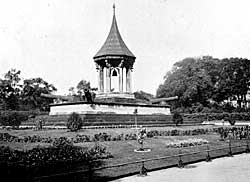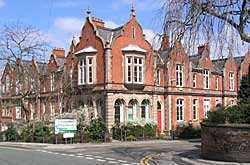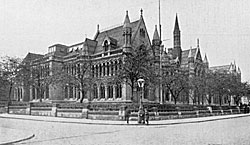< Previous | Contents | Next >
Goldsmith Street, Clarendon Street and Sherwood Street
GOLDSMITH STREET.
Goldsmith Street is not a particularly interesting thoroughfare, and is quite modern in its origin for until the beginning of the 18th century, the town did not stretch further northwards than Parliament Street and, except for a few scattered houses here and there, there was nothing in this direction. The only interesting buildings in the thoroughfare are the Masonic Hall, which was opened on July 2nd, 1881, and St. Andrew's Presbyterian Church, which was built in 1874 from designs by the late Mr. Evans.
Goldsmith Street leads through into Waverley Street, which has a little of interest associated with it, for as early as 1650, it was called the Bowling Alley because there was a bowling green situated where the Vernon Arms and the neighbouring houses are now erected, and this bowling green and coffee house was a well-known rendezvous in the 17th and 18th centuries. "Bowling Alley" was alternatively called "Lingdale" from the word "Ling," meaning heather, and apparently this neighbourhood with the neighbouring Larkdale were country lanes leading to the great open tract which we nowadays call the Forest.

The School of Art, now part of Nottingham Trent University.
The School of Art is, perhaps, the most important building in the thoroughfare, and it was opened with full Masonic honours by the Duke of Newcastle on June 19th, 1865. The design was by an architect of the name of Bakewell, and the curious multi-coloured roof is noteworthy. In front of it stands a statue of Richard Parkes Bonnington, presented to the town by Mr. Watson Fothergill, and surely Bonnington is a man to be highly honoured by the city, for he was the greatest landscape artist of his day. He was born at Arnold in 1802, and the greater part of his life was spent abroad and he died in London in 1828. His pictures are beautiful, and when one has once fallen to their charm, as one may do in the Wallis collection, or to a lesser degree in the Nottingham Castle Collection, one is anxious to get back again and again to see through his eyes the wonderful atmospheric effects in the French coast which he so loved to reproduce.

Chinese Bell Pagoda in the Arboretum in the 1920s.
The Arboretum is a portion of the old common lands of the town which was preserved when the Inclosure took place. It was carefully laid out as a pleasure garden and opened to the public on May 11th, 1851. A great feature was made of the gentle undulations of the land, which were emphasized, and although the park is small it is as beautiful as any park of its size in the country. The great object of interest within its confines is the Chinese Bell which hangs in a pagoda-like structure surrounded by flower beds. This bell was captured at the storming of Canton on December 20th, 1859, and was presented to the town by the officers of the old 59th regiment. The inscription says "that it hung in a joss house," and the origin of that word "joss" is curious, for Canon Isaac Taylor says that this is a corruption of the Portugese word "dios," meaning God, and its association with the east is a memory of the old Portugese merchant explorers of the late Middle Ages.
The terrible statue of Fergus O'Connor, which is mercifully hidden by much greenery, reminds us of the hectic political times of the early 19th century. He was a violent chartist, and was elected for Nottingham in 1847, and presented the monster petition of 1848. Unfortunately he became hopelessly insane and he died in 1855.
CLARENDON STREET.

The former Royal Midland Institute for the Blind has been renamed Clarendon Building and is owned by Nottingham Trent University (photo: A Nicholson, 2004).
Clarendon Street is noticeable for the Royal Midland Institute for the Blind, the foundation of which was laid on August 10th, 1852. We have witnessed the beginning of this noble charity when we saw the little house in Park Street where Miss Chambers first commenced her work amongst the blind.
The Friends burial ground is a small portion cut off from the General Cemetery, and lies on the northern side of Waverley Street, and few people are aware that the little group of cottages adjacent to it are built from a prize design by the late Mr. Evans, who with this design, introduced a new and more comfortable system of accommodation for the working classes.
SHERWOOD STREET.
Sherwood Street is a continuation of Sheep Lane, which has now been modernised into Market Street, and it passed through the sand fields or Sheep Walk of the town. Down to 1852, it was called Shaw's Lane from Parliament Street to Babbington Street, but the northern part, from Babbington Street onwards was called Sherwood Street before that time. Although it was little more than a rough track, it is of great antiquity, as is shown by the fact that it is a sunk road, the traffic having worn down the soft sandstone foundations. Evidence of this remains in the cliff which still exists about Annesley Grove.
The Jews' burial ground on the east side of Sherwood Street almost at its top, was consecrated with considerable ceremony in 1823, but has long been disused and is very difficult of access, while the story of the northern water works, which stood between this burial ground and Forest Road, has been already studied in the opening pages of this itinerary.
Sherwood Street is crossed by Burton Street, which enshrines the ancient name of Burton Leys, a district lying where the Mechanics Institute and the Guildhall are now erected. It seems to have been a rough dump for all manner of rubbish and was something of an eyesore until it was altered and put into order in 1837, when a large number of out-of-work hosiers were found employment thereon. From 1870 to 1886, part of it was used as a cattle market and the present Guildhall was erected in 1887 at a cost of £97,000, Messrs. Verity and Hunt of London being the architects.

University College in the 1920s.
On the other side of Sherwood Street, the University College stands, erected on ground which was formerly called "Horse Fair Close." It was opened by Prince Leopold on June 30th, 1881, and is the outcome of educational lectures delivered to the Mechanics Institute by University Extension Lecturers.
Shakespeare Street is referred to in 1336 as Lingdale Gate, and lying as it does in the valley between two gently-sloping hills, it was conveniently placed to collect all the drainage from these hillsides and, consequently, was always notorious for its unpleasant condition. In fact, so bad did it get that it was called Mud Lane. In 1358, the Jews' gallows stood somewhere here (for no Christian could be hanged upon the same gallows as that which terminated the life of a Jew), but in 1852 it was all tidied up and re-christened Shakespeare Street.
